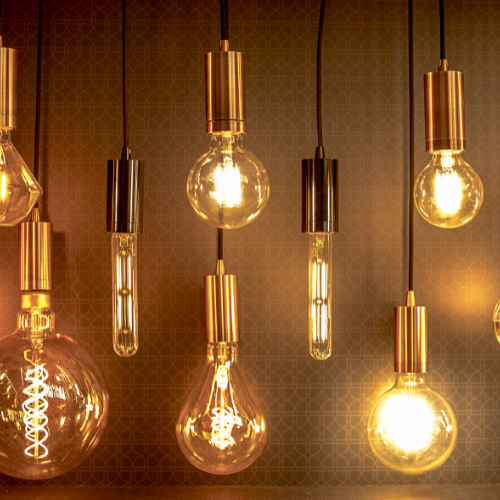The Importance of Lamps & Lighting in Modern Spaces
Lighting
Lamps and lighting play a crucial role in our daily lives, influencing not only the aesthetics of our spaces but also our mood, productivity, and overall well-being. As we progress into the year, the significance of effective lighting solutions continues to grow, driven by advancements in technology and a deeper understanding of how light affects our environment. In this blog, we explore the different types of lamps and lighting options available today, their benefits, and tips for choosing the right lighting for your needs.
Types of Lamps and Lighting Solutions
Incandescent Lamps
Traditional incandescent bulbs are known for their warm glow and ability to render colors accurately. They are widely used in homes and businesses.
• Pros: Affordable, easy to find, and provide excellent color rendering.
• Cons: Less energy-efficient compared to modern alternatives and have a shorter lifespan.
LED Lighting
Light Emitting Diodes (LEDs) have revolutionized the lighting industry with their energy efficiency and longevity.
• Pros: Consume up to 80% less energy than incandescent bulbs, last up to 25 times longer, and are available in various colors and styles.
• Cons: Higher initial cost, though savings on energy bills often offset this over time.
Fluorescent Lamps
Commonly used in commercial settings, fluorescent lamps provide bright, white light.
• Pros: Energy-efficient and longer-lasting than incandescent bulbs.
• Cons: Can flicker or buzz, and some types contain mercury, requiring careful disposal.
Halogen Lamps
A type of incandescent lamp that uses halogen gas to increase brightness.
• Pros: Provide a bright, white light and have a longer lifespan than traditional incandescent bulbs.
• Cons: Can get very hot and are less energy-efficient than LEDs.
Smart Lighting
Smart bulbs can be controlled via smartphone apps or voice assistants, allowing for customizable lighting experiences.
• Pros: Offer convenience through remote control, scheduling, and dimming options. Some can change colors based on mood or time of day.
• Cons: Require a stable Wi-Fi connection and may be more expensive than traditional bulbs.
Benefits of Proper Lighting
Proper lighting enhances comfort, functionality, and safety in any environment. Whether at home or work, lighting design plays a critical role in shaping experiences.
• Enhances Mood and Productivity: Bright, natural-like light can boost energy levels and concentration.
• Improves Safety: Adequate lighting reduces the risk of accidents and deters crime.
• Aesthetic Appeal: Thoughtful lighting design enhances beauty and adds depth to spaces.
• Energy Efficiency: Using LED and smart lighting solutions reduces electricity consumption and costs.
Tips for Choosing the Right Lighting
1. Consider the Purpose of the Space – Identify how the area will be used (reading, cooking, relaxing) and choose lighting accordingly.
2. Layer Your Lighting – Combine ambient, task, and accent lighting to achieve balance.
3. Select the Right Color Temperature – Warm tones (2700K–3000K) for cozy spaces; cool tones (4000K–5000K) for work areas.
4. Incorporate Dimmers – Adjust brightness levels for different moods or times of day.
5. Stay Updated with Trends – Explore modern fixtures and energy-efficient technologies for style and sustainability.
Conclusion
As we embrace 2025, the importance of lamps and lighting continues to evolve alongside technological advancements. Whether you’re looking to enhance your home’s ambiance or improve productivity in a workspace, understanding the various lighting options will help you make informed decisions. By investing in quality lighting, you can create spaces that are functional, safe, and aesthetically pleasing.
Frequently Asked Questions (FAQs)
1. What is the most energy-efficient type of lighting?
LED lighting is the most energy-efficient, using up to 80% less energy than incandescent bulbs.
2. What is ambient lighting?
Ambient lighting provides overall illumination in a room, typically from ceiling fixtures or recessed lights.
3. Can smart lighting save energy?
Yes, smart lighting allows users to schedule, dim, or turn off lights remotely, reducing unnecessary energy use.
4. What color temperature is best for reading areas?
Cool white light (4000K–5000K) is best for reading, as it enhances visibility and reduces eye strain.
5. Does EYBY Marketplace offer lighting solutions?
Yes, EYBY Marketplace provides a wide range of lighting products, including LED, smart, and decorative lamps for residential and commercial applications.
Disclaimer: Accuracy and Reliability of Content
The information in this blog is for general informational purposes only and should not be considered professional advice. While we strive for accuracy and up-to-date content, we make no warranties regarding its completeness, reliability, or suitability. Any reliance on this information is at your own risk, and we disclaim liability for any loss or damage arising from its use. Verify information with other sources and seek professional guidance where needed.
